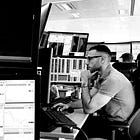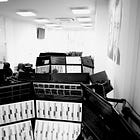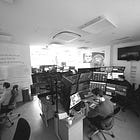Thrive vs Survive: A Market Profile Trader’s Reflections
A Trading Firm’s Q2 2025 Review (Part IV)

Across the AXIA trading desks.
April-June 2025.
This is Part IV. For rest, please see:
The Hero kindly sent Asymmetrist his personal quarterly review. We will explicate a variety of observations.
Let’s permit him the opening shot:
“Good trading isn’t only a matter of thriving when there is opportunity or a specific type of opportunity set, but also of simply surviving during periods of lower opportunity or a different opportunity set.”
On Thriving
The Hero wrote about the characteristics of a “thrive environment” versus “survive,” linked to his market-profile-backed navigation framework. A thrive environment marker is “higher than average auction tempo with healthy profile structures.” It’s qualified further: non-overlapping value areas, clean structure, bulging profile types, and heightened activity around “global auction references.” This shows the power of language. Those fluent in auction theory can visualise the market through the profile and price ladder, and the likely order flow that formed these profiles.
There is further implication. Within this ‘thrive’ environment, price discovery—interchangeable with the market auction—is functioning and dynamic. It’s “healthy.” Higher timeframe participants lead the flow. There is intent to do business, and there is participation.
In Traders of Our Time, we discussed how ‘strategic’ traders like The Hero and The Engineer can position themselves in isolated cases of low market variance, defined by the market taking only a few paths before anything else. This requires a wide information gathering process and identifying when higher timeframe participants are actually “doing business”—i.e. hedging, rotating positions, etc. As The Godfather asked, “What’s paper doing?”—those with firepower to move markets, often because they are forced or must do so in a limited time.
The Hero noted a way to infer this: “Higher than average action around key global auction references, i.e. less exacting price action, suggests higher timeframe control.” Price action is “less exacting” because it is not, as it were, a few electronic locals playing hot potato by nudging the daily high by a tick. There’s more important business to be done today. Haven’t you heard? Tariffs! And we’re holding the bag on this entire portfolio.
Isolate these instances, and less shrewd, tactical dancing on the price ladder is needed. The “access” to that flow is simple. Hence our constant refrain via Bobby Fischer: “Tactics flow from a superior position.” This is useful diagnostically because when markets breach global references, when tempo is elevated, and when price action loses precision, they point to only so many things. The higher timeframe is at work. Focus and energy are now warranted; if things “construct themselves,” it can become the first waypoint to a trade with directional conviction and size.
Why ‘waypoint’ and not ‘signal’ or ‘trigger’ a trade? Consider our trader’s emphasis on timeframe alignment. When the day timeframe aligns with the global auction state—whether balanced or trending—the environment is conducive to trading, but that doesn’t instigate a trade. Understanding the markets through the profile-as-a-framework is to identify the container shaping your trading. It is to identify the canyon ahead to your white-water rafting: the execution of your intraday trading.
Consider the power of inversion. Sometimes, the most important question is: ‘How should it not look?’ This is a powerful priming mechanism in a trader’s framework, both for ‘trade sense’—market navigation and decision-making—and diagnostics. Examples: What is a personal recipe to sabotage myself tomorrow? How can I take a maximum loss on this trade? Where and when is the market unlikely to auction?
Thrive conditions aren’t defined by volatility alone. The Hero isolates a specific opportunity window, defined as: bounded uncertainty. This is where multiple outcomes from a single macro catalyst are possible, but not so uncertain or ‘paradigm-shifting’ that the market can shrug off “today’s business.” That is, where the markets seem locked and unable to poke, prod, or point in any direction—price discovery—until a looming situation is resolved. It’s as if each participant is holding open the door: Why—after you, friend! The auction has become stale and static with no participation. If there’s no participation, little intent can be inferred, leading to less signal in the overriding noise. As our trader wrote:
“Q2 saw a shift away from the highly sensitive day-to-day market approach, as initial shocks softened by volatility-killing events like tariff pauses and short-lived geopolitical uncertainty. The required openness and curiosity during this period was different, because perspective [was] needed to broaden beyond day-to-day business to a future-focused approach ... what does the future look like beyond today?”
If trading within bounded uncertainty, our trader reminds himself that “the most important business to be done is today’s business.” This is the antagonism of monetising the present rather than preserving for the future. If volatility increases, a trader should not be as ‘forward-looking’. In this specific environment, projecting the future onto today is unnecessary and counter-productive. In one shot: Q1 was dynamic enough for The Hero, providing enough opportunity that a trader only had to look ahead. Yet, Q2 was about looking far ahead. In another: if the landscape is flat and the water is slow, you can plan far ahead. If the river bends into an unknown canyon, deal with what’s in front of you—one paddle swing at a time, reading the water, trusting you’ll have time for the next decision.
“Since April, applying the same openness and curiosity to markets hasn’t been as effective as in Q1, due to changed market dynamics requiring a different supply of openness and curiosity. An environment so sensitive to daily developments is not sustainable. Proceeding with the same personal makeup [assumptions] for assessing markets and their offerings is a poor tactic.”
On Surviving
The Hero outlines what defines a ‘survive’ environment. He offers a point that is often ignored: idea generation alone isn’t enough. The auction, or market price discovery, must be “healthy” enough to express the idea.
He aims to identify and avoid low-participation periods: unhealthy auctions (blocky or overlapping profiles), low volume, and a drop in order flow “tempo.” Deterioration in auction health—especially overlapping value areas, lack of excess at extremes, or bulging profile shapes—is a clear sign to stand down. Also, the subtle shift, where higher timeframe information offers diminishing signal for intra-day traders.
He introduces an insight: when he lowers timeframes in search of trades, it’s drift. In his words:
“If a structure isn’t clear on the highest timeframe, trying to make sense of shorter timeframes often leads to mistaking noise for signal.”
Again: denial.
On Adaptation
Our trader notes the lifecycle of macro themes, how they become “saturated” after the initial shock, leading to a self-reinforcing low-volatility regime. For traders who experienced Q1’s elevated activity and sensitivity to headlines, this marks a trap: residual thinking from a prior regime creates false signals in the current one. The market evolves beyond this thinking, but the trader can be stuck in the past.
Residual thinking persists due to ‘temporarily’ consistent market conditions—even years—and becomes self-reinforcing. A conscious and unconscious ‘meta-game’ takes hold. Best practices, the ‘new rules’, and the do’s and don’ts are transmitted through culture, training, and word of mouth. Extend that far enough, and much is justified as “this is how things have always been done.” Hence we’ve returned to On Permanent Revolution: recreation is a continual, hard, and disruptive process. Just as soon as the red-hot revolutionary gains are made they cool down: consolidated, systematised and conserved. Then you need to go again! Yet, it’s the only viable process for a long career. It’s a question of what you want.
Finally, The Hero offers a cognitive marker:
“Feeling like I’m forcing ideas on the market signals we’re not in a thriving environment.”
This reveals a trader actively tracking himself. His discomfort is diagnostic. As he mentioned in Part III: “Treat Emotions As Messages.” His resistance becomes signal. It’s a model of reflexive self-regulation from the ten practitioners in Traders of Our Time. The market and the person are intertwined. You’re always Trading With Your Body, and better for it. Further, conscious thinking dissolves into unconscious competence. To render what John Coates wrote in The Hour Between Dog and Wolf: if you need to think about it, you’re no good. Consider how much one thinks about the biomechanics of kicking a ball before kicking it.
Let’s be clear: novice traders shouldn’t concern themselves with TEAM, diagnostic discomfort, and unconscious competence. You can’t diagnose what you don’t know. You can’t evaluate emotions as signals without the pattern recognition for what’s signal versus noise. You can’t optimise the thing when it doesn’t work! It comes later. To novices, we can only return to first principles: immersion immersion immersion like a frog in boiling water. Per The Engineer in Traders of Our Time, what’s there to be disciplined about as a new trader? Make mistakes and keep going! That’s the learner’s domain. Only when the trader becomes a performer does discipline—denial—become crucial.
P.S:
Some readers will recall our mention of a reply to R.G.’s “letter to the editor” on Part I. His response opened up a set of points and nuances worth giving their own space. Rather than publishing them in here, we’ll let them mature and publish them soon as a standalone piece, for the benefit of both readers and practitioners.
P.P.S:
»Enjoy this brain-teaser cut from the original text!»
Time and volatility are closely linked. If they’re complex and intertwined like the chicken and the egg, what about the triumvirate: time, volatility, and liquidity? If you zoom out enough, they become one. If you zoom in enough, there’s nuance. If you zoom in further, we’re right where we started. Strange!
Acknowledgements, Permissions & Disclaimer
Grateful acknowledgment to AXIA for granting access to their London trading floor and to The Hero for his time and resource access.
The photograph, provided by Axia Futures, is used with their permission, and they retain full ownership and copyright over the image.
Disclaimer: Do Not Do Stupid Financial Decisions. This Is Not A Game.





